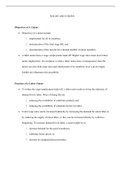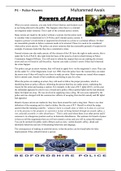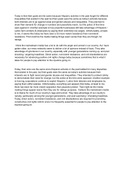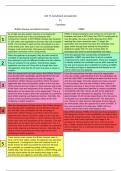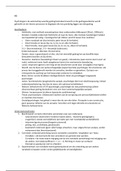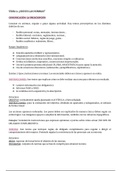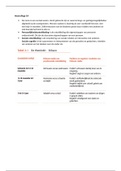Applications of Inorganic Chemistry
Explain reduction and oxidation.
The process of oxidation Oxidation is the process by which an atom, ion, or molecule
loses one or more electrons in the context of chemical reactions. The chemical
species' oxidation state rises as a result of this electron loss. A key idea in redox
(reduction-oxidation) processes, oxidation is frequently seen in reactions where
nonmetals and metals combine to produce ionic compounds. For instance, zinc
oxidises when it loses electrons to generate zinc ions (Zn2 ⁺) in the reaction between
zinc metal and copper ions.
Reduction: On the other hand, reduction is the process by which an atom, ion, or
molecule receives an additional electron, resulting in a lowering of the oxidation state
of the entity. In redox reactions, reduction is the opposite of oxidation. Usually, when
something is reduced, it takes electrons from something that is oxidised. For
instance, the copper ions (Cu²⁺) in the previously discussed process between zinc
metal and copper ions reduce as they acquire electrons to become copper metal
(Cu).
Experiment 1: Standardisation of Sodium Thiosulphate Solution
I prepared a solution of sodium thiosulphate for the first practical. To make sure
there was no contamination, the burette was first rinsed with sodium thiosulphate. I
rubbed a pipette with potassium iodate solution after filling the burette with the
sodium thiosulphate solution, then I put 10 cm³ of this solution into a conical flask. I
mixed in 5 cm³ of diluted sulfuric acid and 2 grams of potassium iodide to this. For
ten minutes, the mixture was left in the dark to facilitate the process.
I then added two or three drops of an indicator starch solution and titrated with
sodium thiosulphate until the blue colour vanished. To make sure it was accurate,
this process was carried out several times. A mean volume of 11.5 ml was obtained
from the burette readings, which were 12.0 ml for trial 1, 11.1 ml for trial 2, and 11.4
ml for trial 3. The standardised concentration of my sodium thiosulphate solution was
given by this mean value.
,Method
1. Rinse Burette: Rinse the burette with sodium thiosulphate solution.
2. Fill Burette: Fill the burette with sodium thiosulphate solution.
3. Rinse Pipette: Rinse a pipette with potassium iodate solution.
4. Transfer Solution: Transfer 10 cm³ of potassium iodate solution into a conical
flask.
5. Add Reagents: Add 2 grams of potassium iodide and 5 cm³ of dilute sulphuric
acid to the conical flask.
6. Reaction Time: Keep the flask in the dark for 10 minutes.
7. Add Indicator: Add 2-3 drops of starch solution to the flask.
8. Titrate: Titrate with sodium thiosulphate solution until the blue colour
disappears.
9. Repeat: Repeat steps 1-3 to ensure accuracy.
Equipment
● Burette
● Pipette
● Conical flask
● Potassium iodate solution
● Sodium thiosulphate solution
● Potassium iodide
● Dilute sulphuric acid
● Starch solution
● Dark storage area
Results
Trial Burette Reading (ml)
1 12.0
2 11.1
3 11.4
mean 11.5
,Conclusion
The adaptability of sodium thiosulfate solution in measuring the concentration of
different analytes, including copper ions, iodine, and other oxidising agents, was
demonstrated by a series of titration studies. With reliable mean volume
measurements, the sodium thiosulfate solution was effectively standardised,
guaranteeing the accuracy of ensuing titrations. The titration method's analytical
capabilities were validated by precisely measuring and calculating the amounts of
copper ions and iodine ions.
Pictures
Experiment 2: Iodine and Thiosulphate Titration
I carried out an iodine and thiosulphate titration for the second practical. I started by
combining 10 millilitres of iodine with 50 millilitres of sodium thiosulphate, which
required 21.5 millilitres of sodium thiosulphate, till the mixture turned clear. I then
added three drops of 1% starch solution to the now-clear iodine solution, anticipating
that the addition of sodium thiosulphate would cause a colour shift. But there was no
noticeable change in colour.
After I carried out the process once more, the iodine solution became transparent at
22 millilitres of sodium thiosulphate. I poured three drops of starch solution once
more, but the colour did not alter. This unexpected outcome raised the possibility of
problems with the concentrations of the solutions employed or the reaction
circumstances.
, Method
1. Mix Solutions: Mix 10 ml of iodine solution with 50 ml of sodium thiosulphate
solution in a conical flask until the solution turns clear.
2. Record Volume: Note the volume of sodium thiosulphate used when the
solution turns clear.
3. Add Indicator: Add 3 drops of 1% starch solution to the clear iodine solution.
4. Observe Colour Change: Observe for any colour change. If no change occurs,
repeat the titration.
5. Repeat: Repeat steps 1-2 to ensure accuracy.
Equipment
● Burette
● Pipette
● Conical flask
● Iodine solution
● Sodium thiosulphate solution
● Starch solution
Result
trial Burette Reading (ml)
1 21.5
2 22.0
mean 21.75
Pictures
Explain reduction and oxidation.
The process of oxidation Oxidation is the process by which an atom, ion, or molecule
loses one or more electrons in the context of chemical reactions. The chemical
species' oxidation state rises as a result of this electron loss. A key idea in redox
(reduction-oxidation) processes, oxidation is frequently seen in reactions where
nonmetals and metals combine to produce ionic compounds. For instance, zinc
oxidises when it loses electrons to generate zinc ions (Zn2 ⁺) in the reaction between
zinc metal and copper ions.
Reduction: On the other hand, reduction is the process by which an atom, ion, or
molecule receives an additional electron, resulting in a lowering of the oxidation state
of the entity. In redox reactions, reduction is the opposite of oxidation. Usually, when
something is reduced, it takes electrons from something that is oxidised. For
instance, the copper ions (Cu²⁺) in the previously discussed process between zinc
metal and copper ions reduce as they acquire electrons to become copper metal
(Cu).
Experiment 1: Standardisation of Sodium Thiosulphate Solution
I prepared a solution of sodium thiosulphate for the first practical. To make sure
there was no contamination, the burette was first rinsed with sodium thiosulphate. I
rubbed a pipette with potassium iodate solution after filling the burette with the
sodium thiosulphate solution, then I put 10 cm³ of this solution into a conical flask. I
mixed in 5 cm³ of diluted sulfuric acid and 2 grams of potassium iodide to this. For
ten minutes, the mixture was left in the dark to facilitate the process.
I then added two or three drops of an indicator starch solution and titrated with
sodium thiosulphate until the blue colour vanished. To make sure it was accurate,
this process was carried out several times. A mean volume of 11.5 ml was obtained
from the burette readings, which were 12.0 ml for trial 1, 11.1 ml for trial 2, and 11.4
ml for trial 3. The standardised concentration of my sodium thiosulphate solution was
given by this mean value.
,Method
1. Rinse Burette: Rinse the burette with sodium thiosulphate solution.
2. Fill Burette: Fill the burette with sodium thiosulphate solution.
3. Rinse Pipette: Rinse a pipette with potassium iodate solution.
4. Transfer Solution: Transfer 10 cm³ of potassium iodate solution into a conical
flask.
5. Add Reagents: Add 2 grams of potassium iodide and 5 cm³ of dilute sulphuric
acid to the conical flask.
6. Reaction Time: Keep the flask in the dark for 10 minutes.
7. Add Indicator: Add 2-3 drops of starch solution to the flask.
8. Titrate: Titrate with sodium thiosulphate solution until the blue colour
disappears.
9. Repeat: Repeat steps 1-3 to ensure accuracy.
Equipment
● Burette
● Pipette
● Conical flask
● Potassium iodate solution
● Sodium thiosulphate solution
● Potassium iodide
● Dilute sulphuric acid
● Starch solution
● Dark storage area
Results
Trial Burette Reading (ml)
1 12.0
2 11.1
3 11.4
mean 11.5
,Conclusion
The adaptability of sodium thiosulfate solution in measuring the concentration of
different analytes, including copper ions, iodine, and other oxidising agents, was
demonstrated by a series of titration studies. With reliable mean volume
measurements, the sodium thiosulfate solution was effectively standardised,
guaranteeing the accuracy of ensuing titrations. The titration method's analytical
capabilities were validated by precisely measuring and calculating the amounts of
copper ions and iodine ions.
Pictures
Experiment 2: Iodine and Thiosulphate Titration
I carried out an iodine and thiosulphate titration for the second practical. I started by
combining 10 millilitres of iodine with 50 millilitres of sodium thiosulphate, which
required 21.5 millilitres of sodium thiosulphate, till the mixture turned clear. I then
added three drops of 1% starch solution to the now-clear iodine solution, anticipating
that the addition of sodium thiosulphate would cause a colour shift. But there was no
noticeable change in colour.
After I carried out the process once more, the iodine solution became transparent at
22 millilitres of sodium thiosulphate. I poured three drops of starch solution once
more, but the colour did not alter. This unexpected outcome raised the possibility of
problems with the concentrations of the solutions employed or the reaction
circumstances.
, Method
1. Mix Solutions: Mix 10 ml of iodine solution with 50 ml of sodium thiosulphate
solution in a conical flask until the solution turns clear.
2. Record Volume: Note the volume of sodium thiosulphate used when the
solution turns clear.
3. Add Indicator: Add 3 drops of 1% starch solution to the clear iodine solution.
4. Observe Colour Change: Observe for any colour change. If no change occurs,
repeat the titration.
5. Repeat: Repeat steps 1-2 to ensure accuracy.
Equipment
● Burette
● Pipette
● Conical flask
● Iodine solution
● Sodium thiosulphate solution
● Starch solution
Result
trial Burette Reading (ml)
1 21.5
2 22.0
mean 21.75
Pictures

